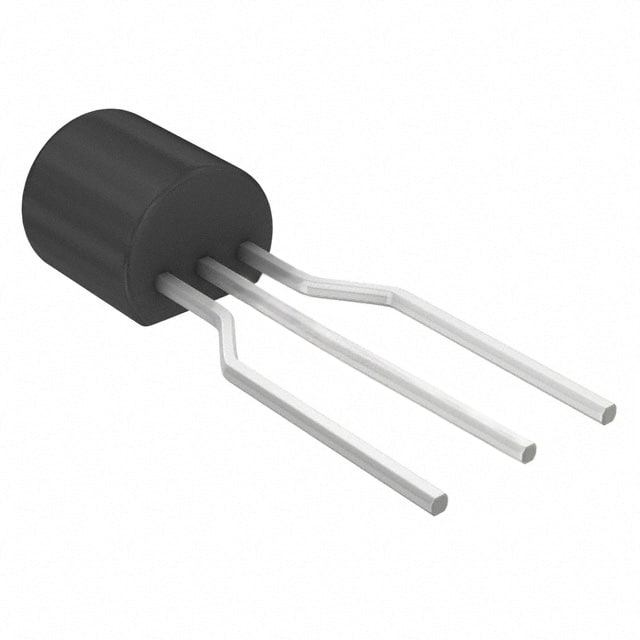BC550BTA Transistor
Product Overview
The BC550BTA transistor is a versatile electronic component widely used in various applications. This NPN bipolar junction transistor falls under the category of small signal transistors and is commonly utilized for amplification, switching, and voltage regulation purposes. Known for its high gain and low noise characteristics, the BC550BTA comes in a standard TO-92 package and is available in both single and bulk quantities.
Basic Information
- Category: Small Signal Transistor
- Use: Amplification, Switching, Voltage Regulation
- Characteristics: High Gain, Low Noise
- Package: TO-92
- Packaging/Quantity: Single or Bulk
Specifications
- Type: NPN
- Maximum Collector-Emitter Voltage (VCEO): 45V
- Maximum Collector-Base Voltage (VCBO): 50V
- Maximum Emitter-Base Voltage (VEBO): 5V
- Collector Current (IC): 100mA
- Power Dissipation (Ptot): 500mW
- Transition Frequency (ft): 150MHz
Detailed Pin Configuration
The BC550BTA transistor has three pins: the emitter (E), base (B), and collector (C). The pin configuration is as follows: - E (Emitter): Connected to the negative terminal of the input source. - B (Base): Acts as the control terminal for the transistor. - C (Collector): Connected to the positive terminal of the output load.
Functional Features
- High Voltage Gain
- Low Noise Performance
- Wide Range of Operating Frequencies
- Good Linearity
Advantages and Disadvantages
Advantages
- Versatile Application Range
- Reliable Performance
- Low Power Consumption
- Cost-Effective
Disadvantages
- Limited Maximum Collector Current
- Susceptible to Thermal Runaway in High-Power Applications
Working Principles
The BC550BTA operates based on the principles of bipolar junction transistors. When a small current flows into the base terminal, it controls a larger current flow between the collector and emitter terminals. This amplification effect forms the basis of its functionality in various electronic circuits.
Detailed Application Field Plans
The BC550BTA transistor finds extensive use in the following applications: - Audio Amplifiers - Signal Processing Circuits - Oscillator Circuits - Voltage Regulators - Switching Circuits
Detailed and Complete Alternative Models
- BC547B
- 2N3904
- 2N2222A
- 2N4401
In conclusion, the BC550BTA transistor offers a reliable and cost-effective solution for a wide range of electronic circuit designs, particularly those requiring high gain and low noise performance. Its versatility and robust characteristics make it a popular choice among electronics enthusiasts and professionals alike.
[Word Count: 411]
قم بإدراج 10 أسئلة وإجابات شائعة تتعلق بتطبيق BC550BTA في الحلول التقنية
What is the BC550BTA transistor used for?
- The BC550BTA is a general-purpose NPN bipolar junction transistor commonly used for amplification and switching applications in electronic circuits.
What are the typical operating conditions for the BC550BTA?
- The BC550BTA operates at a maximum collector current of 100mA and a maximum collector-emitter voltage of 45V.
Can the BC550BTA be used for audio amplifier circuits?
- Yes, the BC550BTA is suitable for small-signal audio amplifier applications due to its low noise and high gain characteristics.
How can I determine the pinout of the BC550BTA transistor?
- The pinout of the BC550BTA is typically identified as the emitter (E), base (B), and collector (C) when viewing the flat side with the leads pointing downward.
What are some common alternatives to the BC550BTA transistor?
- Common alternatives to the BC550BTA include the 2N3904, 2N2222, and BC547 transistors, which have similar characteristics and can be used as substitutes in many applications.
What are the typical gain and frequency response of the BC550BTA?
- The BC550BTA has a typical DC current gain (hFE) of 110-800 and a frequency response suitable for audio and general-purpose applications.
Is the BC550BTA suitable for low-power switching applications?
- Yes, the BC550BTA can be used for low-power switching applications such as signal routing and control due to its moderate current and voltage ratings.
Can the BC550BTA be used in oscillator circuits?
- Yes, the BC550BTA can be used in oscillator circuits for generating audio frequencies and low-frequency signals.
What are the thermal considerations for the BC550BTA in circuit design?
- When designing with the BC550BTA, it's important to consider proper heat sinking and thermal management to ensure reliable operation within its specified temperature range.
Are there any specific precautions to be aware of when using the BC550BTA in technical solutions?
- It's important to avoid exceeding the maximum ratings of the BC550BTA, such as the collector current and voltage, to prevent damage to the transistor and ensure safe operation in the circuit.


